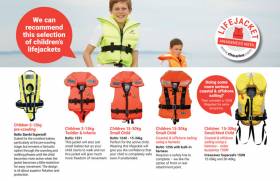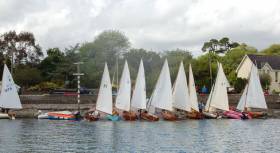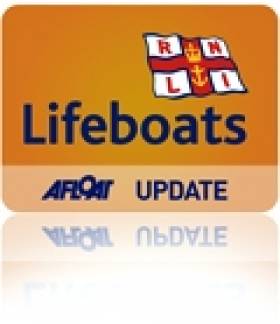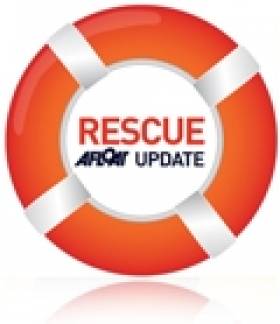Displaying items by tag: Lifejacket
Children's Lifejackets: How to Make The Right Choice
Finding a lifejacket for your child is not difficult but it in terms of water safety it is important to know how to choose the right jacket and what features you should look out for. As part of its Lifejacket Awareness Week, leading chandlery CH Marine has produced an innovative guide to lifejacket purchase for children. The guide is downloadable below as a PDF.
These days, there is a wide choice of designs for infants starting as young as just a few months old and here we list a few of our top tips, to help you make the right choice, giving you absolute confidence in your child’s safety on the water.
Paying attention to comfort, fit, colour and style will make your child love wearing their lifejacket.
When we talk of children’s lifejackets, we are generally talking about the age of 2 months - 6 years, regardless of whether your child can swim a few strokes or not. We must always assume that they can give no assistance in the water and therefore the lifejacket must totally support them and keep their airways clear. For this purpose, you need to choose a jacket that is an approved and classified lifejacket and not a buoyancy aid.
Read also:
Tom MacSweeney's lifejacket safety item in his podcast here
Win a Crewsaver Ergofit Pro Lifejacket Worth €205 In This Free To Enter CH Marine/Afloat.ie Competition here
Welcome to my new series of MacSweeney Podcasts on Afloat, in which I’ll be reporting on sailing and all to do with the culture, history, tradition and development of maritime Ireland.
These short Podcasts, about five minutes duration, will partner the fortnightly broadcast of my This Island Nation programme also here on Afloat, giving readers and listeners a shorter account of the maritime stories which catch my attention.
This week I’m podcasting dinghies, having sailed in one for the first time in 30 years and I am told why you should consider your automatic, gas-inflated lifejacket, in the same way as you would a parachute... Check it and make sure it is maintained....CH Marine says it is servicing 800 of them a month now, which shows that leisure sailors are concerned about their personal safety, which is the message Irish Water Safety is also conveying.
If, despite care, you get into trouble while swimming, the RNLI surprised me a little when they suggested that you should stop fighting the danger you find yourself in and try floating to safety instead.... When you hear how to do it, that’s good, specific advice to be followed.
The dinghy I sailed in was a Rankin, across Cork Harbour and it was a cracking sail. I thoroughly enjoyed it. It’s great to see old boats looked after and returned to the water for sailing.
So now... click below and listen to the Podcast.... In about five minutes you’ll benefit from the safety advice and enjoy the dinghy...
Win a Crewsaver Ergofit Pro Lifejacket Worth €205 In This Free To Enter CH Marine/Afloat.ie Competition here
Starting this Saturday is CH Marine's Life Jacket Awareness Week. The Cork yacht shop has got special offers, competitions and helpful information all about life jackets & safety equipment. The week kicks off with a visit by the RNLI Lifejacket Safe Check Team to CH Marine's Cork City branch this Saturday from 11.00–16.00 hrs.
CH Marine Stage 'Lifejacket Awareness Week'
#lifejacketawareness – Inflatable Lifejackets are without doubt the most convenient and unobtrusive PFDs available but they do need regular checks and servicing for their safe operation when needs. Leading Lifejacket supplier CH Marine is holding a Life Jacket Awareness Week this week and offering information and guidance on the safe use and care of Gas Inflation Lifejackets. The RNLI are attending and, as well as daily tips ,special offers there are also chances to win some great lifejackets. Check out CH Marine Facebook Page for more.
#lifejackets – At the recent (21 and 22 Feb 2015) Angling Ireland Show 2015, 367 anglers from all over Ireland visited the RNLI stand for lifesaving tips and sea safety advice, and to avail of the free lifejacket clinic. Out of the 37 lifejackets brought to the clinic 31 of them were found to have safety issues.
John McKenna, Coastal Safety Officer with Howth RNLI commented, 'A lifejacket is useless if you don't wear it, but it's also important to maintain it properly. Three simple steps could help to save your life - check that the gas canister is in good condition and screwed in properly, the firing head is within its expiry date and that a crotch strap is attached securely.'
As Spring approaches more people will soon be taking to the water. Last year was the busiest year ever for Howth RNLI which had 62 launches and brought 107 people to safety. It was the busiest coastal lifeboat station in Ireland in 2014.
'We want everyone to enjoy the water, but to respect it too. By maintaining and wearing a lifejacket properly, anglers and boat-users will give themselves the best possible chance of survival in the case of an emergency,' added McKenna.
3 tips for maintaining your lifejacket
1. Gas Canister – rusted gas canisters can allow the gas to leak out, they are also abrasive and can wear a hole in the fabric of the lifejacket which would prevent it from inflating properly
2. Firing Head – has an expiry date, make sure it is in date otherwise it won't inflate the lifejacket
3. Crotch Straps – not all lifejackets come with crotch straps, they sometimes have to be bought separately. They are necessary to prevent the lifejacket rising up the body and enable the lifejacket to stay securely in place and work most effectively.
Last year the charity marked 190 years of lifesaving and the RNLI is aiming to reduce coastal drowning significantly by 2024. To do this the charity will be expanding its preventative work and will launch Respect the Water, engaging with water users on how to stay safe and maintain their equipment. Water Safety advice is available on www.rnli.org/safety .
If any angling, sailing or boating clubs would like a member of our Sea Safety Team to give a sea safety presentation and carry out a lifejacket clinic, please contact John McKenna at [email protected] .
Innovative Lifesaving Devices Vie For Design Award
#WaterSafety - A lifejacket that turns into a wetsuit and a special harness that keeps lifejacket wearers upright in the water are in contention for a top innovation prize, as Yachting Monthly reports.
The Hydros personal flotation device (PFD), by Irish designer Kieran Nomroyle, and the TeamO Back Pull lifejacket harness are both in the running for the James Dyson Award - and the £30,000 (€37,800) cheque that comes with it - which is set to be announced on 7 November.
Design graduate Nomroyle explains that his invention was inspired by his role as a lifeguard and medic with the Irish Army Reserve, and he developed Hydros as a solution to the problem of hypothermia for his final year college project.
The TeamO, meanwhile, was developed by solo sailor Oscar Mead from Southampton and attempts to fix a "design flaw" in tethered lifejackets that causes wearers to be dragged through the water face-down.
Yachting Monthly has much more on the story HERE.
Wearing a Lifejacket. What is the Law in Ireland?
A life-jacket is a Personal Flotation Devices (PFD's) and is a statutory requirement for pleasure craft in Ireland. There must be suitable PFDs for everyone on board any pleasure craft and must be worn in the following situations:
1. By anyone on board an open craft that is under 7 meters in length;
2. By anyone on deck on a craft that is under 7 meters length;
3. By anyone under the age of 16 on board an open craft or on deck of any other type of craft;
4. By anyone being towed in another craft or on any other device (skis, donuts etc.);
5. By anyone on a personal watercraft (jet ski).
Exceptions are when:
· Tied up alongside or made fast to an anchor, marina, pier or mooring;
· Immediately prior to, during and after swimming from a craft that is not moving through the water;
· Putting on, wearing or taking off diving equipment on a craft that is not moving through the water.
Marine Notice: Recall of Mullion COMPACT 150N Lifejackets
#MARINE NOTICE - The Department of Transport, Tourism and Sport (DTTAS) has issued a Marine Notice (No 37 of 2012) advising of the recall of certain lifejackets manufactured by Mullion due to a potential problem with their inflation.
In order to avoid any potential safety issue, Mullion is recalling for inspection all COMPACT 150N ISO 12402 lifejackets which have been sold since 1 December 2011 if they have a yellow valve in the oral tube.
COMPACT lifejackets with a red valve in the oral tube are not affected by this recall.
Owners are warned not to use the affected lifejackets and to return them immediately to the nearest Mullion Lifejacket Service Station or the Mullion factory. See www.mullion-pfd.com/compact-life-jacket-recall-programme for more information.
Lifejackets Save Lives - UK Coast Guard
#LIFEJACKETS – There were 95 maritime deaths in the UK in the last five years which might have been prevented if those involved had been wearing a lifejacket or buoyancy aid. These figures were collated following the annual meeting of the Casualty Review Panel in March.
The panel looked at fatal maritime incidents for 2011 and, where there was sufficient information, assessed whether it was probable, possible or unlikely that the person involved could have been saved had they been wearing a lifejacket or buoyancy aid.
In 2011, the panel judged that of the incidents that they considered, it would have been appropriate for 18 people to have worn some form of buoyancy. Of these, 13 would probably or could possibly have been saved had they been wearing a lifejacket or buoyancy aid. Between 2007-11 the panel considered 120 fatalities and in 95 of these cases a life could probably or might possibly have been saved had the person involved been wearing a lifejacket or buoyancy aid.
Commercial fishing and angling are the two riskiest activities where lives might be saved by buoyancy-wear, according to the figures collated by the panel over the last five years.
Transferring between your vessel and the shore is particularly hazardous. Twelve people died boarding or alighting during 2011 and the risk is increased further following alcohol consumption. Eight of these twelve had been drinking before they returned to their vessel. Transferring between a vessel and the shore is a situation where one would not normally be expected to wear a lifejacket or buoyancy aid. Further research will be undertaken regarding this issue.
Angler Dies After Lough Corrib Incident
#RESCUE - One angler has died in hospital and another was receiving emergency treatment last night after their boat got into difficulty on Lough Corrib.
According to The Irish Times, the two men were among a party of three on a boat that was struck by a wave off Annaghdown, which knocked one of them into the water.
Though he was reportedly wearing a lifejacket before he went overboard, an empty jacket was then spotted floating on the surface. One colleague entered the water to search for him but was unsuccessful.
Responding to the distress call from a nearby angling boat, the Irish Coast Guard's Shannon helicopter located the missing angler soon after arriving on scene, some 50 minutes after he entered the water.
The man was airlifted to University Hospital Galway, with the coastguard chopper returning for his colleague when he showed signs of hypothermia.
A small craft warning from Met Éireann was in effect throughout the area at the time of the incident.
The Irish Times has more on the story HERE.






































































